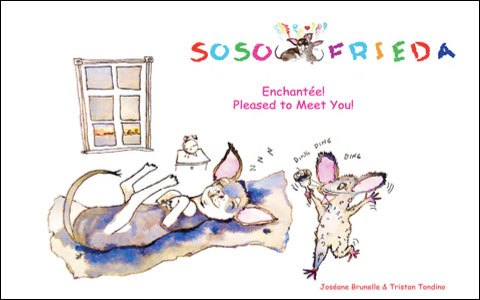
Written by guest bloggers Joël Thibeault and Ian A. Matheson.
Traditionally, literature has followed monolingual standards and norms. As societies become more and more linguistically heterogeneous, and because we now recognize that the learning of a second language relies heavily on the skills developed in the learner’s first language, scholars in language education have started to study the use of a more avant-garde medium in the classroom: dual-language books. In such books, two languages cohabit, and readers can therefore utilize their knowledge of one language to make meaning of passages written in the other.
In the study that was published in the latest issue of the Canadian Modern Language Review, we aimed to examine how elementary readers schooled in French immersion interact with and make meaning of two types of dual-language English-French children’s books. We thus sat down with 16 grade 3-4 students and asked them to read aloud pages of two picture books. In the first book, titled Enchantée!/Pleased to meet you!, passages written in French were an actual translation of the ones written in English. In the second book, Chez Betty & Cat at home, the story is told through the lenses of two characters: the first one tells their perspectives in French, while the other tells theirs in English. As students read aloud each text, we asked them to verbalize the reading strategies they used to comprehend the books. For this particular paper, our analysis focused on how they used cross-linguistic reading strategies—strategies that rely on the interaction of two languages in order to make meaning.

We found that students used four cross-linguistic strategies: the use of equivalent passages in one language to understand the other language, the use of cognates (e.g. docteur/doctor), the use of context provided in the other language, and the use of the dual-language book’s structural features to understand its content. The most prominent strategy that was used was the first one – the use of equivalent passages. While students were able to successfully associate English words to understand the meaning of unknown French words with the translated text, at times they compared irrelevant linguistic features. As far as the second book is concerned, some students did not realize that passages in French were not a mere translation of those in English, and therefore used strategies that were not contextually pertinent. These findings suggest that dual-language children’s books can be a precious pedagogical resource in the French immersion classroom; teachers, however, should not assume that their students will be able to utilize them without an appropriate level of scaffolding.

Joël Thibeault is a professor of French education at the University of Ottawa and adjunct professor at the University of Regina. His research focuses on the teaching and learning of French grammar in plurilingual and minority settings. He is also interested in the use of children’s literature in the teaching of grammar and has conducted studies on the integrated teaching of French and English at school. More information about his research can be found on his university profile.

Ian A. Matheson is certified as an elementary school teacher, and has worked as an occasional teacher, as well as an instructor in specialized programs with adolescents who struggle with literacy. He spent a year as a faculty member in Inclusive Education at the University of Regina prior to coming to Queen’s University. He is a member of the Canadian Research Centre for Inclusive Education, as well as an executive member with the Canadian Association for Educational Psychology.
Joël Thibeault and Ian Matheson’s article in the Canadian Modern Language Review entitled “The Cross-Linguistic Reading Strategies Used by Elementary Students in French Immersion as They Engage with Dual-Language Children’s Books” is available on the UTPJ website.
Comments on this entry are closed.